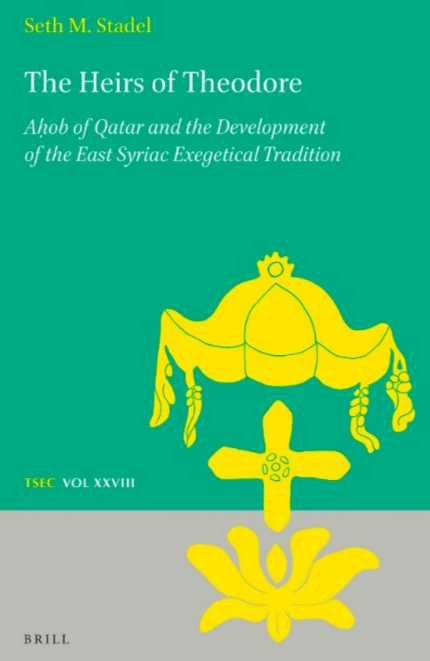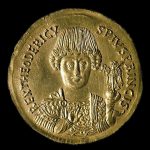Lessons from Aḥob of Qatar
- Erin Thomas Dailey
- 29 January 2024
- 0 Comment

By James Burns and Seth M. Stadel
James:
I have been reading Seth’s new book on Syriac exegesis, the abstract of which is below. When I first joined the DoSSE project, I knew next-to-nothing about the Syriac Christian communities of Late Antiquity; it is one of the delights of the DoSSE project that it enables each of us to expand our horizons by learning about unfamiliar times and places from our expert colleagues.
Seth brings out the distinctiveness of Aḥob of Qatar, a sixth-century East Syriac writer, highlighting the extent to which he diverged from Theodore of Mopsuestia, a Greek writer and bishop who was seen as the Interpreter by the broader East Syriac exegetical tradition. Seth argues that Aḥob was influenced by Jewish sources and actual discussions with Jews. This has important implications for the DoSSE project. One of our aims is to ‘Compare how Christian, Muslim, and Jewish communities interrogated their shared inheritance of ideas and cultural practices’. What Seth’s research on Aḥob really exemplifies is that, within religions, there was variety and disagreement, to the point that certain views of a Christian commentator might derive more from Jewish interpreters than from an authoritative figure in his own religious tradition. How did this come about? Well, Seth emphasises that Aḥob belonged to the provincial school of Seleucia, rather than a main center like the School of Nisibis, and that he interacted with Hebrew as well as Persian and Qatari speakers of different faiths in the wider community.
That we see such diversity in exegesis—a genre of writing which someone, like me, whose primary background is in social history rather than theology, could wrongly assume to be relatively conservative—is worth keeping in mind. We must always be careful about writing of a definitive ‘Christian’, ‘Jewish’ or ‘Islamic’ perspective, especially when it comes to a subject like slavery, which inspired such a range of ideas and practices. Even, or rather especially when, engaged in the cerebral, bookish pursuits of interpreting scripture, our authors were not writing within a social vacuum, but were affected by the communities in which they were embedded: communities where there were slaves; communities made up of people with different perspectives and sometimes different faiths, discussing shared inheritances, practices and problems.
One thing that struck me from the sources Seth translates were the alterations a later commentator made to one of Aḥob’s scholia. Aḥob’s scholion goes like this:
For (it is) not due to (Joseph’s) evil (that) God punished him and turned away from him that he might be [105:17] sold, and he might be bound in slavery as with shackles. But the word of the Lord examined him. But he says his word with regard to his purpose concerning him.
Isho‘dad, a ninth-century writer, modified and preserved part of this scholion as:
for (it is) not due to (Joseph’s) evil (that) he punished him or turned away from him, but on account of (it being) a trial.” The Greek (says), “Until his word came to pass.”
It is all too tempting for me, as a historian of slavery but a layman when it comes to Syriac, to wonder if Isho‘dad’s omission of Aḥob’s explicit mention of Joseph’s slavery was prompted by attachment to a belief that the enslaved did, in fact, earn their lot through their sins. But such speculation would have to be substantiated with reference to Isho‘dad’s broader corpus of writings. Moreover, Seth convincingly suggests that the simplest explanation for the discrepancy is that, in his commentary on the relevant psalm, Isho‘dad was concerned with explaining the meaning of a particular Peshitta verb, and so, he omitted extraneous information. This is another important corrective: not everything is about slavery.
Nonetheless, Seth’s book really highlights the importance and potential of exegesis as an evidence base for Late Antiquity. So far, I have mainly been working with narrative histories and hagiographies, but, thanks to the work of my DoSSE colleagues like Seth, I am increasingly drawn to a wider range of sources. No longer, when I’m searching for key terms on online source databases, will I be tempted to skip over biblical quotations and commentaries!
I am grateful to Seth for reading and reviewing a draft version of these comments.
Abstract of Seth’s book
The Heirs of Theodore: Aḥob of Qatar and the Development of the East Syriac Exegetical Tradition
This volume is a study of Aḥob of Qatar, an important but under-researched late 6th-century East Syriac biblical commentator, and his surviving Old Testament exegetical works (mostly in the form of scholia). It further examines what can be deduced of Aḥob’s influence on the later East Syriac exegetical tradition, and it details the originality of his exegesis, especially in comparison with earlier and/or contemporary Greek and Syriac sources. My argument will be twofold: 1) Aḥob’s exegetical and theological impact on the East Syriac exegetical tradition was more extensive than previously considered, and 2) Aḥob represents a distinct voice within the East Syriac exegetical tradition and so should not be equated with a presumed harmonized monologue in East Syriac biblical exegesis which repeats Theodore of Mopsuestia’s (350-428) exegesis and theology line-by-line.
In Chapter 1, I examine the surviving biographical data relating to Aḥob’s life and works. In Chapter 2, I present an annotated edition and English translation of Aḥob’s Cause of the Psalms and surviving attributed Old Testament scholia, as well as a discussion of disputed scholia and spurious scholia connected to Aḥob. In Chapters 3 and 4, I analyze Aḥob’s Old Testament exegetical works as they were used and developed by later East Syriac writers and manuscript traditions, including Nathniel of Shirzor’s (ca. 600) Cause of the Psalms, The Commentary on Genesis-Exodus 9:32 (first half of the 8th century), Theodore bar Koni’s Scholion (792/793), the Denḥa-Grigor Commentary (first half of the 9th century?), Isho‘dad of Merv’s (fl. ca. 850) Commentary on Genesis, 1 Samuel, and Psalms, the Anonymous Commentary (10th century), Bar Bahlul’s Lexicon (mid-10th century-early 20th century), and Isaac Shbadnaya’s (fl. 1439/1440) prose commentary on his Poem on God’s Governance from ‘In the Beginning’ until Eternity. In Chapter 5, I investigate four aspects of Aḥob’s Old Testament exegetical works: 1) their original form, 2) their original purpose, 3) their multiple sources, and 4) their overall distinctiveness within the East Syriac exegetical tradition. I conclude this volume with an Appendix, which presents an edition of the Introduction and select parts of thirteen psalms from the Denḥa-Grigor Commentary, to which Aḥob’s Psalm scholia are connected.




